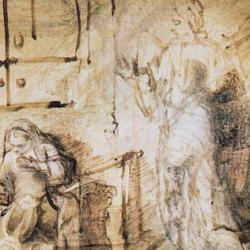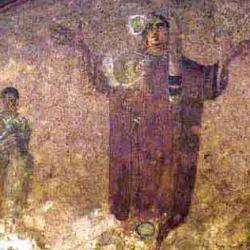The following paragraphs are snipped from an article of mine on God and time in Genesis 1, published in the Criswell Theological Review. You can find more information about this issue of the journal here.
It seems significant that Genesis describes this evening-and-morning pattern without reference to the category of “time.” As far as Genesis 1 is concerned, what exists is not “time” but “light” and “darkness,” separated and renamed as “day” and “night.”
“Time” suggests a homogenous, undifferentiated sequence of moments, but day and night have different qualities (at least: being light and dark, respectively), and the light and dark are ordered to move from darkness to light, evening to morning, as the creation itself began in darkness before being brightened by divine fiat.
In the light of Genesis 1, the God-and-time question may be reconceived more concretely: Does the God who spoke light, separated it from darkness, and ordered light and dark into a recurring sequence then speak, do, make, and create according the rhythm of days that He inaugurated? He is God the Creator of Days. Is He also God in days?
Day 3 introduces a variation of the pattern. For the first time, God speaks twice, first to separate the waters below so that dry land can appear (1:9), and then to command earth to sprout grasses and fruit-bearing trees (1:11). Both follow the pattern established in Days 1-2: God speaks . . . and it was so.
That double command marks the shift from “forming” to “filling,” from Elohim’s response to the tohu to a response to the bohu. The first speech of Day 3 completes the three-decker cosmos of the Bible – heaven/firmament above, dry land below, and waters under the earth. With the second speech, the middle zone, earth, begins to be filled, first with vegetation.
The shift to filling marks a shift also from monergistic creative activity to a synergism of Elohim and creation. There is another “let there be” on Day 4, as Elohim fills the firmament with heavenly lights. During most of the last half of the creation week, however, the Creator creates by empowering creation to bring forth new things. Earth brings forth the vegetation not because Elohim says “Let there be vegetation” but because Elohim says “Let the earth sprout vegetation” (1:11-12).
Waters teem because He says “Let the waters teem with swarms of living things” (though the tannanim are created [bara’] directly by God, 1:21). Creatures spring from earth like plants because Elohim says “let the earth bring forth living creatures” (1:24). Man, made in the image of God, is another special creation (bara’), but we learn in Genesis 2 that the creation of man as male and female was the product of a sequence of actions – forming ‘adam from the ‘adamah, then the woman from the man.
Left to itself, earth and water are inert, unproductive. Empowered by the Word of God, earth sprouts plants and living animals, and water teems swarms of fish. God creates by bestowing the power to bear fruit on His creation. (As Athanasius said, God is not enviously protective of His power.)
These mediated, synergistic acts of creation are included in the summary of Genesis 2:1-3. These are among God’s works, among the things “which He had done,” among the work that “God had created and made” (2:2-3). Though earth produced plants and creatures, plants and living things are among God’s works. He made them, albeit through the agency of Word-empowered earth and water.
The most dramatic indication of God’s immanence to the created pattern of evening and morning is the repeated “say-see” sequence that structures most of the creation days. God says “Let there be light” and then see that the light is good (1:3-4). God says, “Let the waters below the heavens be gathered” and sees that it is good (1:9-10). He speaks again, “Let the earth sprout grasses,” and when it does he sees that it is good (1:11-12). He speaks and makes and places the lights of heaven, and sees that it is good (1:14, 16-18). He calls the waters to teem with creatures and the sky with birds, and sees that it is good (1:20-21). He speaks “Let the earth bring forth living creatures,” and when it does, he sees that it is good (1:24-25).
When all is said and done, He sees that it is all “very good” (1:31). In the Bible, eyes are organs of evaluation and judgment. Each day of creation week (except the second) is judgment day, in which God inspects and declares His favorable judgment of the creation.[1]
Say-see is an irreversible sequence. It would make no sense for God to “see” what is good, and then to “say” it into existence. He must say and then see, act then judge, do then evaluate what has been done. Creation is, as we have seen, involved in its own completion, but that involvement is overarched by, embedded between, God’s word of command and His subsequent word of judgment.
Creation’s self-formation originates from God’s word and moves toward God’s word. God says to the land “sprout plants” and then “sees” that it was good; He speaks to the waters to teem, and judges that the resulting teeming is good. God’s originating speech enables the creation’s liveliness, and God’s concluding speech evaluates creation’s fruit. Creation’s contribution is enclosed within two acts of divine speech, one prospective and one retrospective, one enabling and the other evaluative.
[1] Perhaps we should take this as simple divine self-approval, God ending each day with a hearty pat on His own back: Well done, Divine Self! Within the canon as a whole, it seems rather that we should read this as one of several hints of a plurality of speakers, makers, and doers within Elohim (one of the hints, of course, being the plural name). Augustine asks whether the creation account points to the Trinity in the sequence of “God said,” “God made” and “God saw.” Is “the Father giving a kind of order to the Son” and does the Holy Spirit see and pronounce good? (Literal Meaning of Genesis, 2.11, in Augustine, On Genesis [trans. Edmund Hill; Hyde Park: New City Press, 2006] 197). Augustine dismisses the suggestion that the Father commands the Son as incompatible with “the unity of the Trinity.”












